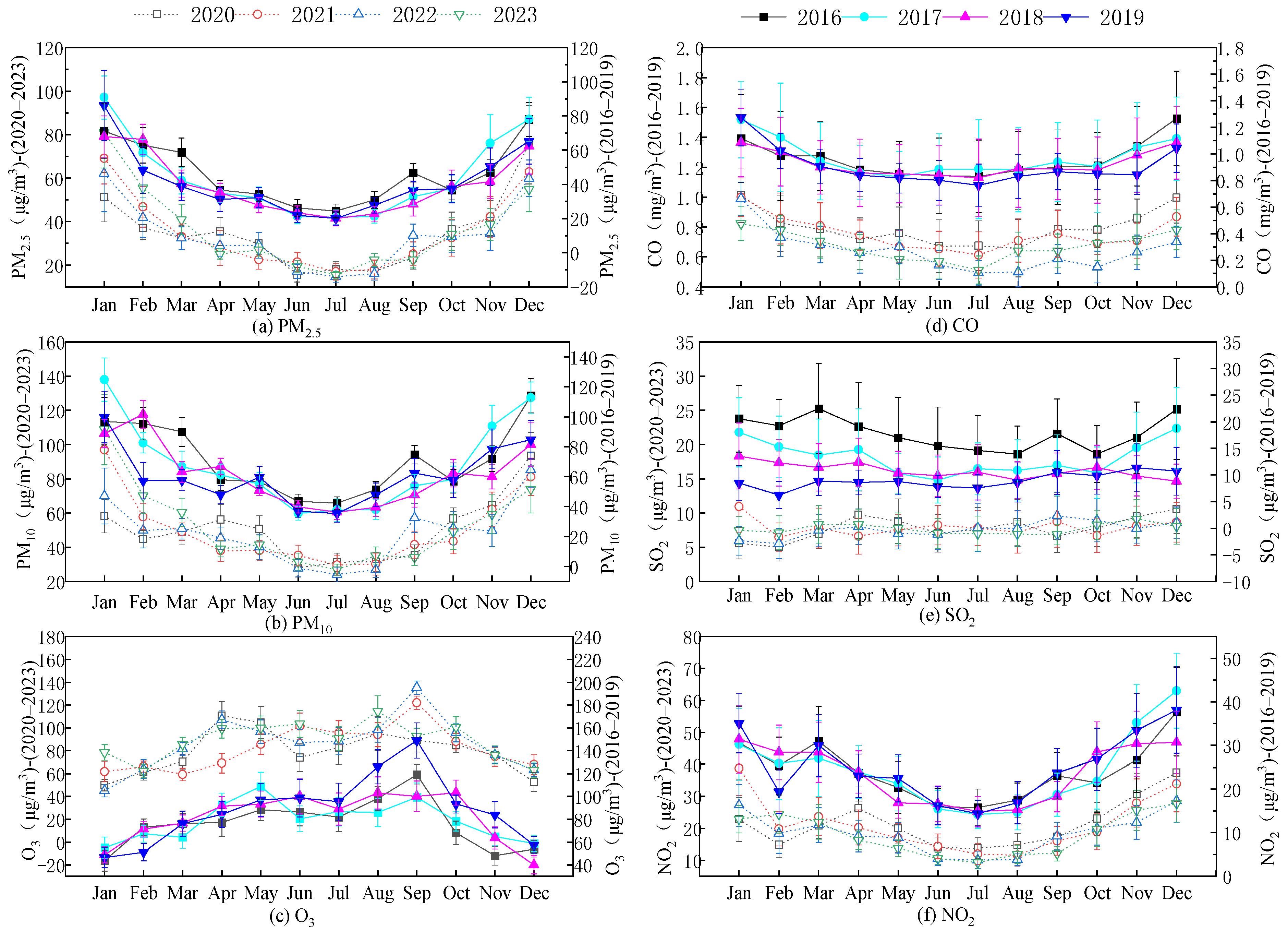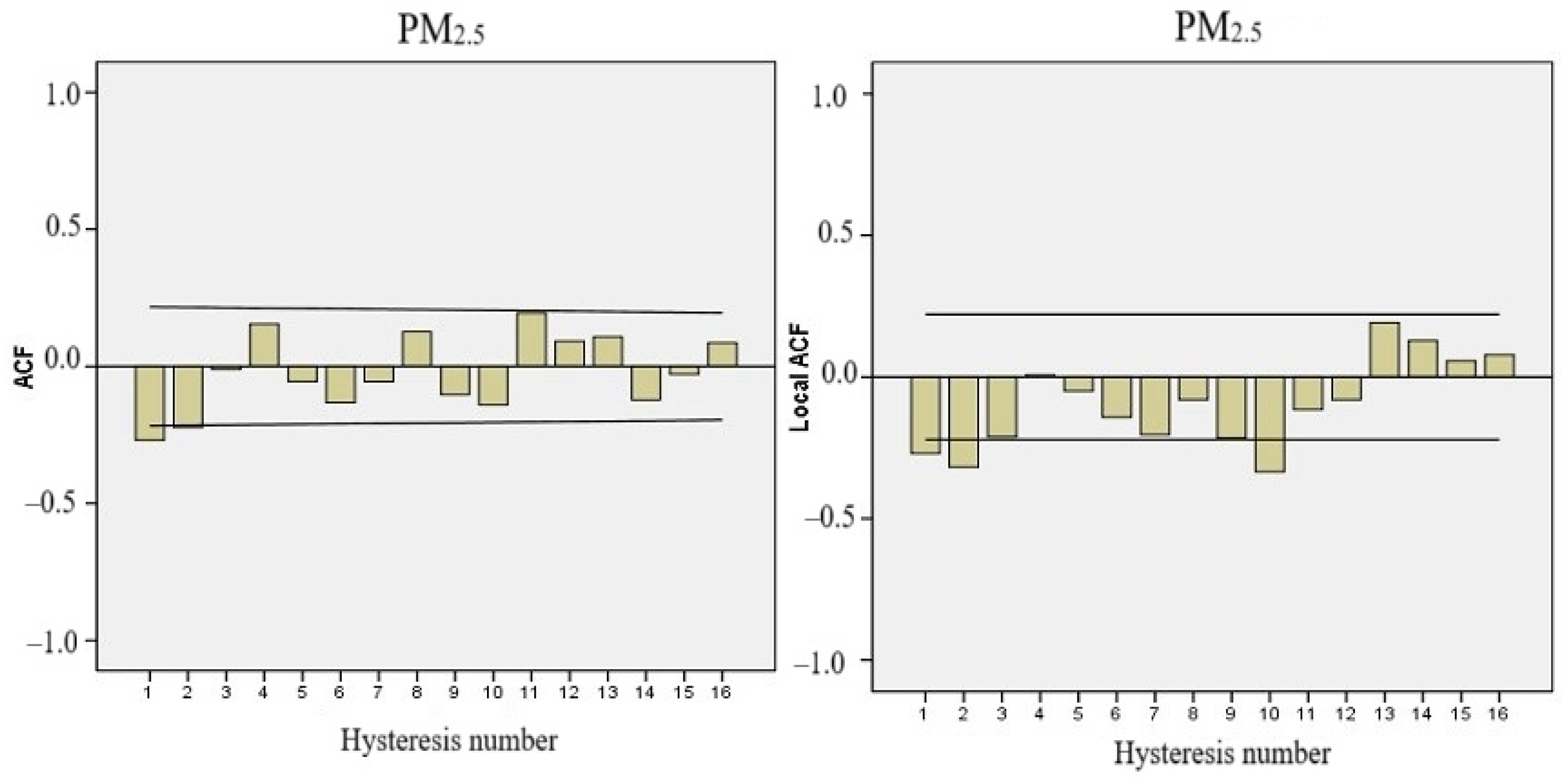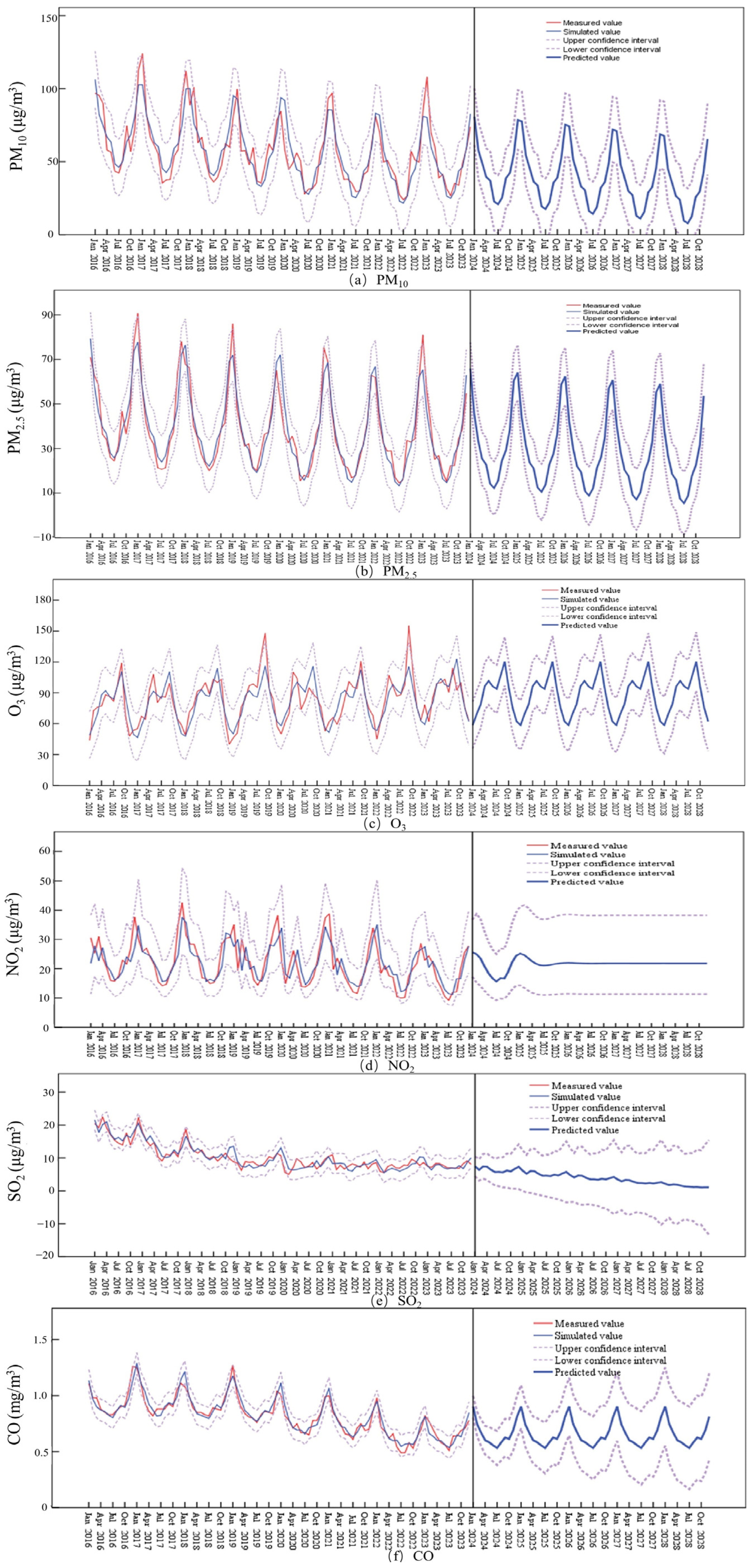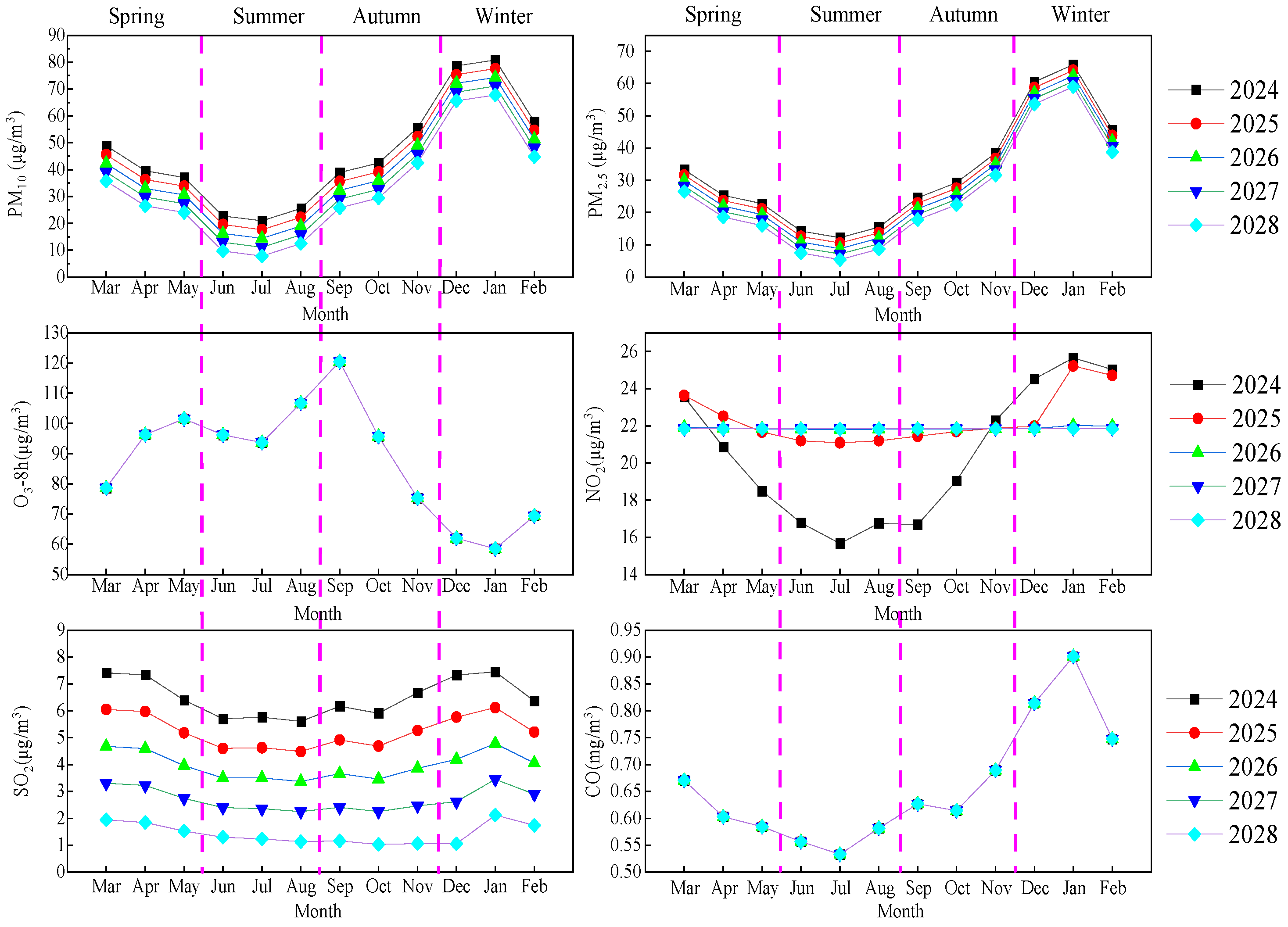Analysis and Prediction of Atmospheric Environmental Quality Based on the Autoregressive Integrated Moving Average Model (ARIMA) Model in Hunan Province, China
Abstract
:1. Introduction
2. Materials and Methods
2.1. Study Area
2.2. Data Sources
2.3. Research Methods
2.3.1. Data Pre-Processing
2.3.2. ARIMA Model
3. Results and Discussion
3.1. Evaluation of the Quality of Atmospheric Environment in Hunan Province
3.2. Predicted Results of Atmospheric Quality
3.2.1. Construction of ARIMA Models
3.2.2. The Predictive Results Based on the ARIMA Model
- (1)
- Prediction curves of PM2.5 and PM10
- (2)
- Prediction curve of O3
- (3)
- Prediction curve of NO2
- (4)
- Prediction curve of SO2
- (5)
- Prediction curve of CO
3.3. Discussion
3.4. Model Validation
4. Conclusions
- (1)
- The forecasting results of PM10, PM2.5, SO2, and CO were developed well with an R2 of 0.817~0.918 based on ARIMA model; meanwhile, the forecasting results of NO2 and O3 were less than satisfactory with an R2 of 0.697~0.723.
- (2)
- During the period of 2016–2023, the ambient air quality of Hunan province was maintained at a Class II range (AQI = 51–100). Meanwhile, PM10, PM2.5, and O3 in Hunan Province stably matched the Class II standard of ambient air quality for China; the rest of other air pollutants met the Class I standard.
- (3)
- PM10 and PM2.5 are major air containments for impacting the ambient air quality of Hunan Province; meanwhile, O3 is an air pollutant of major concern in the near future for Hunan Province; the contamination levels of NO2, SO2, and CO are in relatively safe ranges.
- (4)
- The ARIMA model prediction method is simple and convenient, and it can be widely used in outdoor air quality assessment.
Author Contributions
Funding
Data Availability Statement
Conflicts of Interest
Abbreviations
| ARIMA | Autoregressive integrated moving average |
| AQI | Air quality index |
| PM10 | Respirable particulate matter |
| PM2.5 | Fine particulate matter |
| O3-8 h | Average of the maximum consecutive eight-hour ozone concentration in 24 h daily |
References
- Gu, C.; Hu, L.; Cook, I.G. China’s urbanization in 1949–2015: Processes and driving forces. Chin. Geogr. Sci. 2017, 27, 847–859. [Google Scholar] [CrossRef]
- Gu, C. Urbanization: Processes and driving forces. Sci. China-Earth Sci. 2019, 62, 1351–1360. [Google Scholar] [CrossRef]
- Yang, S. The specific historical process of urbanization in China. Vopr. Istor. 2023, 1, 172–179. [Google Scholar] [CrossRef]
- Goldstone, J.A. The New Population Bomb The Flour Megatrends That Will Change the World. Foreign Aff. 2010, 89, 31–42. [Google Scholar]
- Ding, X.; Zhong, W.; Shearmur, R.G.; Zhang, X.; Huisingh, D. An inclusive model for assessing the sustainability of cities in developing countries—Trinity of Cities’ Sustainability from Spatial, Logical and Time Dimensions (TCS-SLTD). J. Clean. Prod. 2015, 109, 62–75. [Google Scholar] [CrossRef]
- Han, B.; Ma, Z.; Liu, Y.; Wang, M.; Lin, Y. Effect of Urban-Rural Income Gap on the Population Peri-Urbanization Rate in China. Land 2021, 10, 1255. [Google Scholar] [CrossRef]
- Zhang, H.; Ma, R.; Cui, L.; Tian, G.; Ma, Z. Exploring the impacts of energy and environmental constraints on China’s urbanization process. Comput. Ind. Eng. 2022, 169, 108170. [Google Scholar] [CrossRef]
- Zhou, W.-Y.; Yang, W.-L.; Wan, W.-X.; Zhang, J.; Zhou, W.; Yang, H.-S.; Yang, H.; Xiao, H.; Deng, S.-H.; Shen, F.; et al. The influences of industrial gross domestic product, urbanization rate, environmental investment, and coal consumption on industrial air pollutant emission in China. Environ. Ecol. Stat. 2018, 25, 429–442. [Google Scholar] [CrossRef]
- Gryech, I.; Asaad, C.; Ghogho, M.; Kobbane, A. Applications of machine learning & Internet of Things for outdoor air pollution monitoring and prediction: A systematic literature review. Eng. Appl. Artif. Intell. 2024, 137–143, 109182. [Google Scholar] [CrossRef]
- Shen, L.; Shuai, C.; Jiao, L.; Tan, Y.; Song, X. Dynamic sustainability performance during urbanization process between BRICS countries. Habitat Int. 2017, 60, 19–33. [Google Scholar] [CrossRef]
- Xu, W.; Yao, L.; Fu, X.; Wang, Y.; Sun, S. Response of PM2.5 variations to changing urbanization process in different climatic backgrounds of China. Urban Clim. 2022, 45, 101273. [Google Scholar] [CrossRef]
- Tang, X.; Chen, X.; Tian, Y. Chemical composition and source apportionment of PM2.5—A case study from one year continuous sampling in the Chang-Zhu-Tan urban agglomeration. Atmos. Pollut. Res. 2017, 8, 885–899. [Google Scholar] [CrossRef]
- Dai, S.; Chen, X.; Liang, J.; Li, X.; Li, S.; Chen, G.; Chen, Z.; Bin, J.; Tang, Y.; Li, X. Response of PM2.5 pollution to meteorological and anthropogenic emissions changes during COVID-19 lockdown in Hunan Province based on WRF-Chem model. Environ. Pollut. 2023, 331, 121886. [Google Scholar] [CrossRef] [PubMed]
- Chen, X.; Li, X.; Liang, J.; Li, X.; Li, S.; Chen, G.; Chen, Z.; Dai, S.; Bin, J.; Tang, Y. Causes of the unexpected slowness in reducing winter PM2.5 for 2014-2018 in Henan Province. Environ. Pollut. 2023, 319, 120928. [Google Scholar] [CrossRef] [PubMed]
- Li, J.; Dai, Y.; Zhu, Y.; Tang, X.; Wang, S.; Xing, J.; Zhao, B.; Fan, S.; Long, S.; Fang, T. Improvements of response surface modeling with self-adaptive machine learning method for PM2.5 and O3 predictions. J. Environ. Manag. 2022, 303, 114210. [Google Scholar] [CrossRef]
- Song, Y.; Liu, B.; Chen, X.; Liu, J. Atmospheric Pollution Mapping of the Yangtze River Basin: An AQI-Based Weighted Co-Word Analysis. Int. J. Environ. Res. Public Health 2020, 17, 817. [Google Scholar] [CrossRef]
- Chakraborty, D.; Elhegazy, H.; Elzarka, H.; Gutierrez, L. A novel construction cost prediction model using hybrid natural and light gradient boosting. Adv. Eng. Inform. 2020, 46, 101201. [Google Scholar] [CrossRef]
- Shi, T.; Hu, Y.; Liu, M.; Li, C.; Zhang, C.; Liu, C. How Do Economic Growth, Urbanization, and Industrialization Affect Fine Particulate Matter Concentrations? An Assessment in Liaoning Province, China. Int. J. Environ. Res. Public Health 2020, 17, 5441. [Google Scholar] [CrossRef]
- Wang, J.; He, D. Sustainable urban development in China: Challenges and achievements. Mitig. Adapt. Strateg. Glob. Chang. 2015, 20, 665–682. [Google Scholar] [CrossRef]
- Huang, Z.; An, X.; Cai, X.; Chen, Y.; Liang, Y.; Hu, S.; Wang, H. The impact of new urbanization on PM2.5 concentration based on spatial spillover effects: Evidence from 283 cities in China. Sustain. Cities Soc. 2023, 90, 104386. [Google Scholar] [CrossRef]
- Basagana, X.; Rivera, M.; Aguilera, I.; Agis, D.; Bouso, L.; Elosua, R.; Foraster, M.; de Nazelle, A.; Nieuwenhuijsen, M.; Vila, J.; et al. Effect of the number of measurement sites on land use regression models in estimating local air pollution. Atmos. Environ. 2012, 54, 634–642. [Google Scholar] [CrossRef]
- Rivera, M.; Basagana, X.; Aguilera, I.; Agis, D.; Bouso, L.; Foraster, M.; Medina-Ramon, M.; Pey, J.; Kuenzli, N.; Hoek, G. Spatial distribution of ultrafine particles in urban settings: A land use regression model. Atmos. Environ. 2012, 54, 657–666. [Google Scholar] [CrossRef]
- Morley, D.W.; Gulliver, J. A land use regression variable generation, modelling and prediction tool for air pollution exposure assessment. Environ. Model. Softw. 2018, 105, 17–23. [Google Scholar] [CrossRef]
- Jiang, H.; Zheng, G.; Yi, Y.; Chen, D.; Zhang, W.; Yang, K.; Miller, C.E. Progress and Challenges in Studying Regional Permafrost in the Tibetan Plateau Using Satellite Remote Sensing and Models. Front. Earth Sci. 2020, 8, 560403. [Google Scholar] [CrossRef]
- Chen, D.; Zhong, Y.; Ma, A.; Zhang, L. Blurry dense object extraction based on buffer parsing network for high-resolution satellite remote sensing imagery. Isprs J. Photogramm. Remote Sens. 2024, 207, 122–140. [Google Scholar] [CrossRef]
- Muthukumar, P.; Cocom, E.; Nagrecha, K.; Comer, D.; Burga, I.; Taub, J.; Calvert, C.F.; Holm, J.; Pourhomayoun, M. Predicting PM2.5 atmospheric air pollution using deep learning with meteorological data and ground-based observations and remote-sensing satellite big data. Air Qual. Atmos. Health 2022, 15, 1221–1234. [Google Scholar] [CrossRef]
- Xue, T.; Zheng, Y.; Geng, G.; Zheng, B.; Jiang, X.; Zhang, Q.; He, K. Fusing Observational, Satellite Remote Sensing and Air Quality Model Simulated Data to Estimate Spatiotemporal Variations of PM2.5 Exposure in China. Remote Sens. 2017, 9, 221. [Google Scholar] [CrossRef]
- Azid, A.; Juahir, H.; Toriman, M.E.; Kamarudin, M.K.A.; Saudi, A.S.M.; Hasnam, C.N.C.; Aziz, N.A.A.; Azaman, F.; Latif, M.T.; Zainuddin, S.F.M.; et al. Prediction of the Level of Air Pollution Using Principal Component Analysis and Artificial Neural Network Techniques: A Case Study in Malaysia. Water Air Soil Pollut. 2014, 225, 2063. [Google Scholar] [CrossRef]
- Rahman, E.A.; Hamzah, F.M.; Latif, M.T.; Azid, A. Forecasting PM2.5 in Malaysia Using a Hybrid Model. Aerosol Air Qual. Res. 2023, 23, 230006. [Google Scholar] [CrossRef]
- de Lima, B.D.; de Cassia Marques Alves, R.; de Oliveira, G.G.; Paim, B.L. The performance of artificial neural networks for modeling daily concentrations of particulate matter from meteorological data. Environ. Monit. Assess. 2023, 195, 1305. [Google Scholar] [CrossRef]
- Guo, Q.; He, Z.; Wang, Z. Prediction of Hourly PM2.5 and PM10 Concentrations in Chongqing City in China Based on Artificial Neural Network. Aerosol Air Qual. Res. 2023, 23, 220448. [Google Scholar] [CrossRef]
- Muthukumar, P.; Nagrecha, K.; Comer, D.; Calvert, C.F.; Amini, N.; Holm, J.; Pourhomayoun, M. PM2.5 Air Pollution Prediction through Deep Learning Using Multisource Meteorological, Wildfire, and Heat Data. Atmosphere 2022, 13, 822. [Google Scholar] [CrossRef]
- Hu, K.; Guo, X.; Gong, X.; Wang, X.; Liang, J.; Li, D. Air quality prediction using spatio-temporal deep learning. Atmos. Pollut. Res. 2022, 13, 101543. [Google Scholar] [CrossRef]
- Liao, Q.; Zhu, M.; Wu, L.; Pan, X.; Tang, X.; Wang, Z. Deep Learning for Air Quality Forecasts: A Review. Curr. Pollut. Rep. 2020, 6, 399–409. [Google Scholar] [CrossRef]
- Sun, K.; Tang, L.; Qian, J.; Wang, G.; Lou, C. A deep learning-based PM2.5 concentration estimator. Displays 2021, 69, 102072. [Google Scholar] [CrossRef]
- Peng, J.; Han, H.; Yi, Y.; Huang, H.; Xie, L. Machine learning and deep learning modeling and simulation for predicting PM2.5 concentrations. Chemosphere 2022, 308, 136353. [Google Scholar] [CrossRef]
- Wang, S.; Ren, Y.; Xia, B. Estimation of urban AQI based on interpretable machine learning. Environ. Sci. Pollut. Res. 2023, 30, 96562–96574. [Google Scholar] [CrossRef]
- Masih, A. Machine learning algorithms in air quality modeling. Glob. J. Environ. Sci. Manag.-Gjesm 2019, 5, 515–534. [Google Scholar] [CrossRef]
- Mendez, M.; Merayo, M.G.; Nunez, M. Machine learning algorithms to forecast air quality: A survey. Artif. Intell. Rev. 2023, 56, 10031–10066. [Google Scholar] [CrossRef]
- Aladağ, E. Forecasting of particulate matter with a hybrid ARIMA model based on wavelet transformation and seasonal adjustment. Urban Clim. 2021, 39, 100930. [Google Scholar] [CrossRef]
- Zhao, L.; Li, Z.; Qu, L. Forecasting of Beijing PM2.5 with a hybrid ARIMA model based on integrated AIC and improved GS fixed-order methods and seasonal decomposition. Heliyon 2022, 8, e12239. [Google Scholar] [CrossRef] [PubMed]
- Pyae, T.S.; Kallawicha, K. First temporal distribution model of ambient air pollutants (PM2.5, PM10, and O3) in Yangon City, Myanmar during 2019–2021. Environ. Pollut. 2024, 347, 123718. [Google Scholar] [CrossRef] [PubMed]
- Yang, C.-H.; Chen, P.-H.; Wu, C.-H.; Yang, C.-S.; Chuang, L.-Y. Deep learning-based air pollution analysis on carbon monoxide in Taiwan. Ecol. Inform. 2024, 80, 102477. [Google Scholar] [CrossRef]
- Al Yammahi, A.; Aung, Z. Forecasting the concentration of NO2 using statistical and machine learning methods: A case study in the UAE. Heliyon 2023, 9, 125–134. [Google Scholar] [CrossRef] [PubMed]
- Luo, J.; Gong, Y. Air pollutant prediction based on ARIMA-WOA-LSTM model. Atmos. Pollut. Res. 2023, 14, 101761. [Google Scholar] [CrossRef]
- Li, Y.; Liu, B.; Xue, Z.; Zhang, Y.; Sun, X.; Song, C.; Dai, Q.; Fu, R.; Tai, Y.; Gao, J.; et al. Chemical characteristics and source apportionment of PM2.5 using PMF modelling coupled with 1-hr resolution online air pollutant dataset for Linfen, China. Environ. Pollut. 2020, 263, 114532. [Google Scholar] [CrossRef]
- Rahman, M.; Rashid, F.; Kumar, D.; Habib, M.A.; Ullah, A. Dataset of air pollutants (PM2.5, PM10, CO) concentrations in the export processing area of Dhaka, Bangladesh. Data Brief 2024, 55, 110594. [Google Scholar] [CrossRef]
- Bose, A.; Chowdhury, I.R. Towards cleaner air in Siliguri: A comprehensive study of PM2.5 and PM10 through advance computational forecasting models for effective environmental interventions. Atmos. Pollut. Res. 2024, 15, 101976. [Google Scholar] [CrossRef]
- Liu, X.; Sun, T.; Feng, Q. Dynamic spatial spillover effect of urbanization on environmental pollution in China considering the inertia characteristics of environmental pollution. Sustain. Cities Soc. 2020, 53, 101903. [Google Scholar] [CrossRef]
- Han, F.; Lu, X.; Xiao, C.; Chang, M.; Huang, K. Estimation of Health Effects and Economic Losses from Ambient Air Pollution in Undeveloped Areas: Evidence from Guangxi, China. Int. J. Environ. Res. Public Health 2019, 16, 2707. [Google Scholar] [CrossRef]
- Gunasekar, S.; Kumar, G.J.R.; Agbulu, G.P. Air Quality Predictions in Urban Areas Using Hybrid ARIMA and Metaheuristic LSTM. Comput. Syst. Sci. Eng. 2022, 43, 1271–1284. [Google Scholar] [CrossRef]
- Ramadan, M.S.; Abuelgasim, A.; Al Hosani, N. Advancing air quality forecasting in Abu Dhabi, UAE using time series models. Front. Environ. Sci. 2024, 12, 1393878. [Google Scholar] [CrossRef]
- Wang, P.; Zhang, H.; Qin, Z.; Zhang, G. A novel hybrid-Garch model based on ARIMA and SVM for PM2.5 concentrations forecasting. Atmos. Pollut. Res. 2017, 8, 850–860. [Google Scholar] [CrossRef]
- Liu, H.; Wu, H.; Lv, X.; Ren, Z.; Liu, M.; Li, Y.; Shi, H. An intelligent hybrid model for air pollutant concentrations forecasting: Case of Beijing in China. Sustain. Cities Soc. 2019, 47, 101471. [Google Scholar] [CrossRef]
- Zhao, J.-H.; Feng, G.-L.; Zhi, R. Progresses and prospects in research on season division and seasonal changes in China. J. Trop. Meteorol. 2013, 19, 28–38. [Google Scholar]
- Cao, L.-T.; Liu, H.-H.; Li, J.; Yin, X.-D.; Duan, Y.; Wang, J. Relationship of meteorological factors and human brucellosis in Hebei province, China. Sci. Total Environ. 2020, 703, 135491. [Google Scholar] [CrossRef]
- GB3095-2012; Ambient Air Quality Standards. China Environmental Science Publishing House: Beijing, China, 2012.
- Lin, X.; Lu, C.; Song, K.; Su, Y.; Lei, Y.; Zhong, L.; Gao, Y. Analysis of Coupling Coordination Variance between Urbanization Quality and Eco-Environment Pressure: A Case Study of the West Taiwan Strait Urban Agglomeration, China. Sustainability 2020, 12, 2643. [Google Scholar] [CrossRef]
- Chen, Y.; Zhu, Z.; Cheng, S. Industrial agglomeration and haze pollution: Evidence from China. Sci. Total Environ. 2022, 845, 157392. [Google Scholar] [CrossRef]






| Parameter | Pre-Interpolation | Post-Interpolation | ||||||
|---|---|---|---|---|---|---|---|---|
| Number of Cases | Number of Missing Data | Number of Cases | Number of Outliers | Min | Max | Mean | SD | |
| PM10 | 40,487 | 427 | 39,000 | 1914 | 4 | 145 | 53.51 | 28.53 |
| PM2.5 | 40,608 | 306 | 39,121 | 1793 | 2 | 102 | 35.23 | 20.75 |
| O3 | 40,908 | 6 | 40,591 | 323 | 3 | 185 | 82.15 | 35.81 |
| NO2 | 40,908 | 6 | 39,607 | 1307 | 1 | 50 | 20.76 | 10.07 |
| SO2 | 40,906 | 8 | 38,448 | 2466 | 1 | 22 | 8.86 | 4.63 |
| CO | 40,908 | 6 | 40,106 | 808 | 0.1 | 1.6 | 0.81 | 0.28 |
| Parameter | Unit | Spring | Summer | Autumn | Winter | Mean Value |
|---|---|---|---|---|---|---|
| PM10 | μg/m3 | 53.8 ± 11.7 | 35.1 ± 6.9 | 57.6 ± 13.5 | 84.6 ± 21.3 | 57.8 ± 20.4 |
| PM2.5 | μg/m3 | 33.7 ± 7.3 | 20.5 ± 4.1 | 37.3 ± 9.0 | 63.9 ± 13.6 | 38.9 ± 18.2 |
| O3 | μg/m3 | 87.3 ± 14.3 | 94.0 ± 11.3 | 92.3 ± 25.5 | 58.4 ± 9.9 | 83.0 ± 16.6 |
| NO2 | μg/m3 | 22.0 ± 4.4 | 13.8 ± 2.4 | 23.3 ± 5.8 | 28.9 ± 7.2 | 22.0 ± 6.2 |
| SO2 | μg/m3 | 10.5 ± 4.1 | 9.1 ± 2.5 | 10.3 ± 3.0 | 11.0 ± 5.3 | 10.2 ± 0.8 |
| CO | mg/m3 | 0.8 ± 0.1 | 0.7 ± 0.1 | 0.8 ± 0.1 | 1.0 ± 0.2 | 0.8 ± 0.1 |
| Parameter | PM10 | PM2.5 | O3 | NO2 | SO2 | CO |
|---|---|---|---|---|---|---|
| ARIMA (p,d,q) | (2,0,2) | (2,0,2) | (2,1,2) | (2,1,2) | (3,1,3) | (2,1,2) |
| R2 | 0.817 | 0.896 | 0.723 | 0.697 | 0.852 | 0.918 |
| MSE | 9.763 | 5.928 | 11.442 | 4.274 | 1.508 | 0.049 |
| MAE | 7.529 | 4.363 | 8.611 | 3.244 | 1.157 | 0.037 |
| p value | 0.952 | 0.945 | 0.964 | 0.976 | 0.919 | 0.971 |
| Parameter | PM10 | PM2.5 | O3 | NO2 | SO2 | CO |
|---|---|---|---|---|---|---|
| Unit | μg/m3 | μg/m3 | μg/m3 | μg/m3 | μg/m3 | mg/m3 |
| 2024 | 45.7 | 32.3 | 87.9 | 20.4 | 6.5 | 0.7 |
| 2025 | 42.5 | 30.6 | 87.9 | 22.3 | 5.2 | 0.7 |
| 2026 | 39.2 | 28.9 | 87.9 | 21.9 | 4.0 | 0.7 |
| 2027 | 35.9 | 27.2 | 87.9 | 21.8 | 2.7 | 0.7 |
| 2028 | 32.7 | 25.5 | 87.9 | 21.8 | 1.4 | 0.7 |
| Indicator | Accuracy | R2 | ARIMA (p,d,q) |
|---|---|---|---|
| PM10 | 92.4% | 0.817 | (2,0,2) |
| PM2.5 | 90.0% | 0.896 | (2,0,2) |
| O3 | 92.4% | 0.723 | (2,1,2) |
| NO2 | 67.7% | 0.697 | (2,1,2) |
| SO2 | 82.9% | 0.852 | (3,1,3) |
| CO | 94.1% | 0.918 | (2,1,2) |
Disclaimer/Publisher’s Note: The statements, opinions and data contained in all publications are solely those of the individual author(s) and contributor(s) and not of MDPI and/or the editor(s). MDPI and/or the editor(s) disclaim responsibility for any injury to people or property resulting from any ideas, methods, instructions or products referred to in the content. |
© 2024 by the authors. Licensee MDPI, Basel, Switzerland. This article is an open access article distributed under the terms and conditions of the Creative Commons Attribution (CC BY) license (https://creativecommons.org/licenses/by/4.0/).
Share and Cite
Gao, W.; Xiao, T.; Zou, L.; Li, H.; Gu, S. Analysis and Prediction of Atmospheric Environmental Quality Based on the Autoregressive Integrated Moving Average Model (ARIMA) Model in Hunan Province, China. Sustainability 2024, 16, 8471. https://doi.org/10.3390/su16198471
Gao W, Xiao T, Zou L, Li H, Gu S. Analysis and Prediction of Atmospheric Environmental Quality Based on the Autoregressive Integrated Moving Average Model (ARIMA) Model in Hunan Province, China. Sustainability. 2024; 16(19):8471. https://doi.org/10.3390/su16198471
Chicago/Turabian StyleGao, Wenyuan, Tongjue Xiao, Lin Zou, Huan Li, and Shengbo Gu. 2024. "Analysis and Prediction of Atmospheric Environmental Quality Based on the Autoregressive Integrated Moving Average Model (ARIMA) Model in Hunan Province, China" Sustainability 16, no. 19: 8471. https://doi.org/10.3390/su16198471





